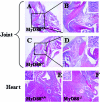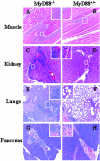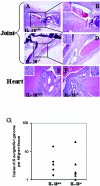MyD88 deficiency results in tissue-specific changes in cytokine induction and inflammation in interleukin-18-independent mice infected with Borrelia burgdorferi
- PMID: 16495516
- PMCID: PMC1418660
- DOI: 10.1128/IAI.74.3.1462-1470.2006
MyD88 deficiency results in tissue-specific changes in cytokine induction and inflammation in interleukin-18-independent mice infected with Borrelia burgdorferi
Abstract
Toll-like receptors (TLRs) play an important role in the control of infection with Borrelia burgdorferi. Deficiencies in TLR-2 or the shared TLR adapter molecule MyD88 have been shown to result in greatly increased bacterial burdens in mice. However, although in vitro studies have shown that the activation of TLR pathways by B. burgdorferi results in the release of inflammatory cytokines, studies in deficient mice have shown either no change or increased rather than decreased inflammation in infected animals. In this study, we looked at mechanisms to explain the increase in inflammation in the absence of MyD88. We found that MyD88-deficient mice infected with B. burgdorferi did not show increased inflammation at sites typically associated with Lyme disease (joints and heart). However, there was markedly increased inflammation in the muscles, kidneys, pancreas, and lungs of deficient animals. Muscle inflammation was typically seen perivascularly and perineuronally similar to that seen in infected humans. Chemotactic chemokines and cytokines were greatly increased in the muscle and kidneys of MyD88-deficient animals but not in the joints or heart tissue, suggesting that MyD88-independent pathways for recognizing B. burgdorferi and inducing these chemokines are present in the muscle and kidneys. Interleukin-18 signaling through MyD88 does not appear to play a role in either control of infection or inflammation.
Figures






Similar articles
-
Myeloid differentiation antigen 88 deficiency impairs pathogen clearance but does not alter inflammation in Borrelia burgdorferi-infected mice.Infect Immun. 2004 Jun;72(6):3195-203. doi: 10.1128/IAI.72.6.3195-3203.2004. Infect Immun. 2004. PMID: 15155621 Free PMC article.
-
MyD88 plays a unique role in host defense but not arthritis development in Lyme disease.J Immunol. 2004 Aug 1;173(3):2003-10. doi: 10.4049/jimmunol.173.3.2003. J Immunol. 2004. PMID: 15265935
-
Dual role for Fcγ receptors in host defense and disease in Borrelia burgdorferi-infected mice.Front Cell Infect Microbiol. 2014 Jun 11;4:75. doi: 10.3389/fcimb.2014.00075. eCollection 2014. Front Cell Infect Microbiol. 2014. PMID: 24967215 Free PMC article.
-
Chemokines and Toll-like receptors in Lyme disease pathogenesis.Trends Mol Med. 2005 Mar;11(3):114-20. doi: 10.1016/j.molmed.2005.01.003. Trends Mol Med. 2005. PMID: 15760769 Review.
-
Mechanisms of Borrelia burgdorferi internalization and intracellular innate immune signaling.Front Cell Infect Microbiol. 2014 Dec 15;4:175. doi: 10.3389/fcimb.2014.00175. eCollection 2014. Front Cell Infect Microbiol. 2014. PMID: 25566512 Free PMC article. Review.
Cited by
-
The Lyme disease spirochete Borrelia burgdorferi utilizes multiple ligands, including RNA, for interferon regulatory factor 3-dependent induction of type I interferon-responsive genes.Infect Immun. 2010 Jul;78(7):3144-53. doi: 10.1128/IAI.01070-09. Epub 2010 Apr 19. Infect Immun. 2010. PMID: 20404081 Free PMC article.
-
Phagosomal TLR signaling upon Borrelia burgdorferi infection.Front Cell Infect Microbiol. 2014 May 20;4:55. doi: 10.3389/fcimb.2014.00055. eCollection 2014. Front Cell Infect Microbiol. 2014. PMID: 24904837 Free PMC article. Review.
-
MyD88 in Mycobacterium tuberculosis infection.Med Microbiol Immunol. 2017 Jun;206(3):187-193. doi: 10.1007/s00430-017-0495-0. Epub 2017 Feb 20. Med Microbiol Immunol. 2017. PMID: 28220253 Review.
-
Tick sialostatins L and L2 differentially influence dendritic cell responses to Borrelia spirochetes.Parasit Vectors. 2015 May 15;8:275. doi: 10.1186/s13071-015-0887-1. Parasit Vectors. 2015. PMID: 25975355 Free PMC article.
-
Biology of infection with Borrelia burgdorferi.Infect Dis Clin North Am. 2008 Jun;22(2):217-34, v. doi: 10.1016/j.idc.2007.12.013. Infect Dis Clin North Am. 2008. PMID: 18452798 Free PMC article. Review.
References
-
- Adachi, O., T. Kawai, K. Takeda, M. Matsumoto, H. Tsutsui, M. Sakagami, K. Nakanishi, and S. Akira. 1998. Targeted disruption of the MyD88 gene results in loss of IL-1- and IL-18-mediated function. Immunity 9:143-150. - PubMed
-
- Akira, S. 2000. Toll-like receptors: lessons from knockout mice. Biochem. Soc. Trans. 28:551-556. - PubMed
-
- Akira, S., and K. Takeda. 2004. Toll-like receptor signalling. Nat. Rev. Immunol. 4:499-511. - PubMed
-
- Asbrink, E., and A. Hovmark. 1988. Early and late cutaneous manifestations in Ixodes-borne borreliosis (erythema migrans borreliosis, Lyme borreliosis). Ann. N. Y. Acad. Sci. 539:4-15. - PubMed
-
- Banda, N. K., A. Vondracek, D. Kraus, C. A. Dinarello, S. H. Kim, A. Bendele, G. Senaldi, and W. P. Arend. 2003. Mechanisms of inhibition of collagen-induced arthritis by murine IL-18 binding protein. J. Immunol. 170:2100-2105. - PubMed
Publication types
MeSH terms
Substances
Grants and funding
LinkOut - more resources
Full Text Sources
Medical
Molecular Biology Databases

